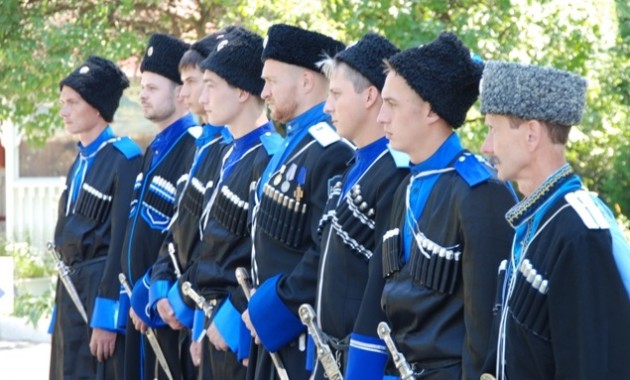
Moscow May be Unimpressed by Cossacks’ Performance as Protectors of Russian Interests in North Caucasus
Publication: North Caucasus Weekly Volume: 16 Issue: 8
By:

The process of electing the Terek Cossack ataman (chieftain) has been quite public and scandalous this year. Moscow’s envoy to the North Caucasus, Sergei Melikov, outlined the views of the government on the future of the Cossacks. He said the entire structure of the currently highly fractured Terek Cossack forces should be “reformatted” to produce a unified Terek Cossack Military. Melikov said he would support a Cossack chieftain candidate who “is not affiliated with any structures, has no criminal background, does not promulgate nationalism, and is not supported by friends in high places” (Interfax, March 26).
Melikov appears to be willing to rationalize the existence of numerous Cossack organizations in the North Caucasus. The official said that “registered Cossacks, unregistered Cossacks and perhaps some other type of Cossacks are going to be invented. Those people who are Cossacks and want to engage in state service have long served in the army; after finishing military institutions and academies, they work in the police; they have long engaged in business for the benefit of their own Cossack brethren and the Stavropol region” (Terkv.ru, accessed April 22).
The reason for the authorities’ barely disguised irritation is the numerous scandals in which Cossack leaders have been implicated recently, such as highly publicized murders (Newsru.com, August 14, 2014). The most notorious murder took place in September 2014 at a local hospital of the city of Mineralnye Vody. Cossack chieftain Yevgeny Smirnov was implicated as “the best friend” of the murderers, who had apparently committed many other crimes previously but had avoided punishment (Komsomolskaya Pravda, December 2, 2014).
The economic aspect of the relationship between the Cossacks and the government in the North Caucasus Federal District, especially in the Stavropol region, is also quite controversial and little publicized. The southern and eastern parts of Stavropol region are the most conflict-prone areas, where the economic interests of ethnic Russians and ethnic North Caucasians often come into conflict. Eastern Stavropol region is particularly known for a steady increase in the presence of non-ethnic-Russian Dagestanis, especially Dargins, and a corresponding outflow of ethnic Russians. The authorities of Stavropol region, which has a predominantly ethnic-Russian population, have been concerned about the trend. The Russian authorities in general have repeatedly stressed that they regard the outflow of ethnic Russians from the North Caucasus and their replacement with non-ethnic-Russian North Caucasians as a security threat. The Russian government fears that with the loss of ethnic Russians, their control over the North Caucasus and even parts of Stavropol region may also fade. Therefore, the authorities quite openly prefer ethnic Russians over other ethnic groups arriving from other parts of the country.
However, the high birthrates among the North Caucasians, low birthrates among ethnic Russians and deindustrialization are pushing out ethnic Russians and free up the land for the North Caucasians who have significantly less arable land per capita in their republics and are poorer than Stavropol’s residents. This process is not necessarily adversarial, but rather mutually beneficial from an economic point of view. Ethnic Russians have more profitable places to move to, such as Moscow and other Russian cities. Non-ethnic-Russian North Caucasians are often discriminated against in large Russian cities where the majority of well-paid jobs are to be found. As a result of migration processes in eastern Stavropol, each part of the population fills the best spots available.
However, the Russian government’s obsession with the security dilemma of “losing” eastern Stavropol region to migration by North Caucasians has prompted the government to grant a legally questionable elevated status to the Cossacks. The Cossacks have habitually received property rights to the primary commodity in these rural areas—land. The logic behind the move was that, after receiving land, the Cossacks would remain there and affirm the presence of ethnic Russians in the region. Instead, the Cossacks started to fight with each other and other ethnic groups over property because the administrative mechanisms of land ownership were not transparent. While ethnic Russians and Cossacks are, in a certain way, “more equal” than others and periodically lose or win legal battles with each other, non-ethnic-Russian Dagestanis find themselves on the losing end most of the time.
The latest such scandal took place in Stepnovsky district in eastern Stavropol. The leader of the Dagestani community stated that one of the Cossack leaders told him openly that “Dagstanis will never work on the Cossacks’ land.” Dagestani attempts to legalize the ownership of land they cultivate are futile because the courts are invariably on the side of the Cossacks if the latter lay claim. Despite all the hurdles, demography and other economic factors trump administrative barriers. Cossacks do not have enough manpower to cultivate the land, so they rent it out to Dagestanis and others. The end result is that the Dagestanis reportedly cultivate nearly twice as much arable land in Stepnovsky district as ethnic Russians (Kavkazskaya Politika, March 18).
Economically motivated migration in eastern Stavropol is the rational reaction of local residents and migrants. Yet, given the highly politicized views of ethnic Russians on their role in the country, the situation becomes highly conflict ridden. The Cossacks, who are meant to spearhead Russia’s defenses against the influx of North Caucasians, have become, instead, a superfluous intermediary in financial transactions that extract profits but provide nothing in return. The rationalizing economic environment in the region is likely to put pressure on the government to rid the region of Cossack financial intermediaries.




